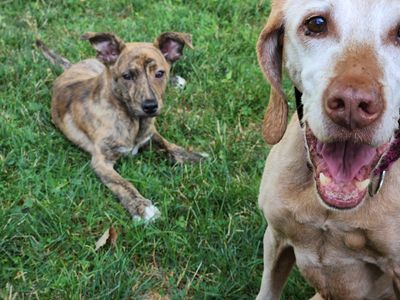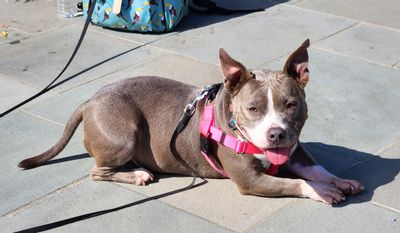Recognizing Stress in Dogs: A Guide to Calming Signals and Anxiety Signs
Identifying a Stressed Dog

As a trainer and holistic pet health coach, I often see dogs trying their best to tell us when they're feeling overwhelmed or anxious. Understanding these subtle signals isn't just about preventing problems – it's about building trust and creating a more peaceful life for our four-legged family members.
The Language of Stress: Understanding Your Dog's Warning Signs
1. Common Calming Signals
Dogs have developed sophisticated ways to communicate their discomfort and attempt to diffuse tension:
• Lip Licking (when no food is present)
What it means: Your dog is feeling uncertain or trying to calm themselves
When you might see it: During training sessions, meeting new people, or in unfamiliar environments
• Yawning Out of Context
What it means: Not tiredness, but rather stress or anxiety
When you might see it: During vet visits, when children are too energetic, or in crowded spaces
• Looking Away or Head Turning
What it means: Your dog needs a break from a situation
When you might see it: During intense training, when someone is staring at them, or in overwhelming situations
2. Body Language Stress Indicators
• The "Shake Off"
What it means: Releasing tension (like we might take a deep breath)
When you might see it: After a tense moment, following training, or during new experiences
• Changes in Body Position
- Lowered head
- Tucked tail
- Tense muscles
- Crouched position
These often indicate your dog is feeling uncomfortable or overwhelmed
3. Subtle Signs That Are Easy to Miss
• Excessive Panting (when not hot or exercising)
• Drooling more than usual
• Showing whale eyes (white portion of eyes visible)
• Excessive scratching when not itchy
• Inability to focus on treats or toys
Creating a Stress-Free Environment: Positive Solutions
When you notice these signals, here's how to help:
1. Give Space
• Allow your dog to retreat if they need to
• Create a quiet "safe zone" in your home
• Never force interactions
2. Adjust the Environment
• Reduce noise levels
• Minimize overwhelming situations
• Control the pace of introductions to new experiences
3. Use Positive Reinforcement
• Reward calm behavior
• Practice confidence-building exercises
• Keep training sessions short and successful
Pro Tip: Every dog is unique in how they display stress. Start keeping a "stress diary" to learn your dog's personal signals.
The Power of Prevention
Understanding stress signals allows you to:
• Prevent anxiety from escalating
• Build trust with your dog
• Create more effective training sessions
• Improve your dog's overall wellbeing
• Strengthen your bond through understanding
Remember: Stress signals aren't "bad behavior" – they're your dog's way of communicating their needs. By responding appropriately, you're showing them they can trust you to keep them safe and comfortable.
Next Steps for Pet Parents
Start observing your dog in various situations:
• During routine activities
• In new environments
• Around different people and dogs
• During training sessions
Keep track of what you notice, and begin responding to these signals early – prevention is always better than cure!
Stay tuned for our final installment in this series, where we'll explore the joy of reading happy and relaxed body language in our dogs!




